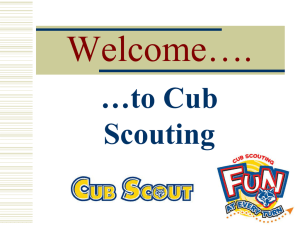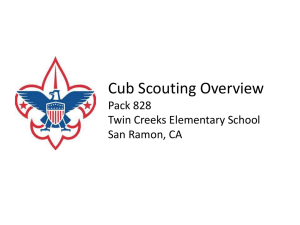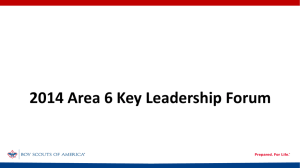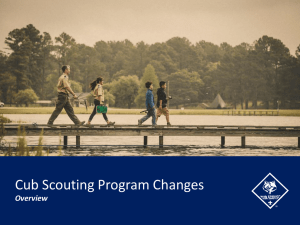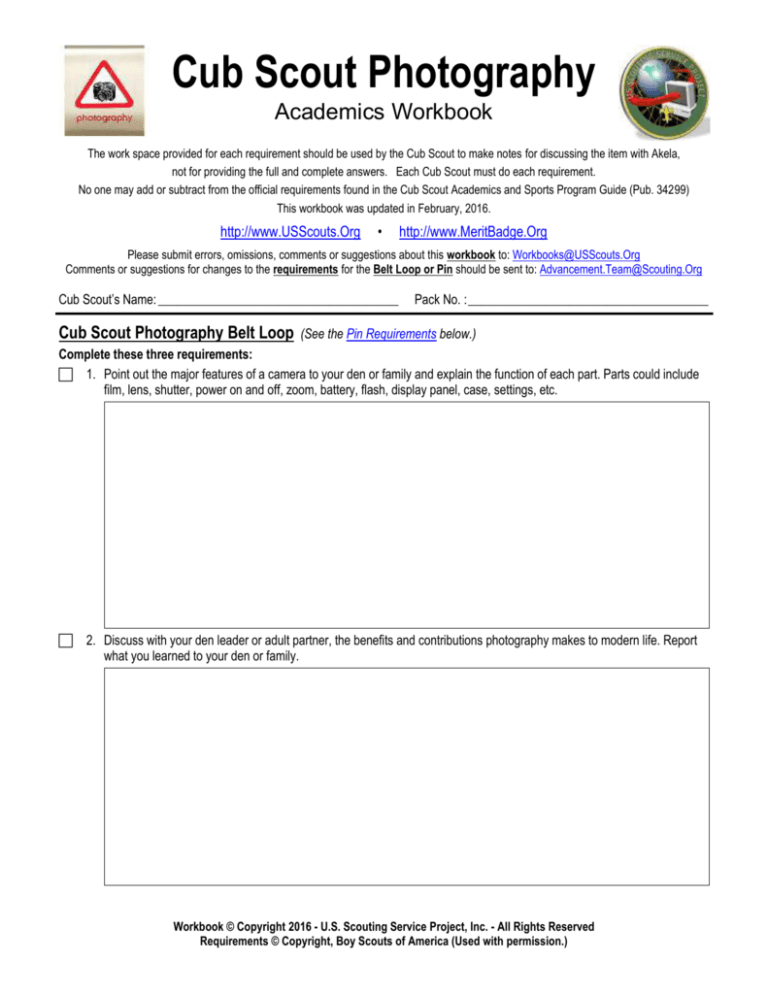
Cub Scout Photography
Academics Workbook
The work space provided for each requirement should be used by the Cub Scout to make notes for discussing the item with Akela,
not for providing the full and complete answers. Each Cub Scout must do each requirement.
No one may add or subtract from the official requirements found in the Cub Scout Academics and Sports Program Guide (Pub. 34299)
This workbook was updated in February, 2016.
http://www.USScouts.Org
•
http://www.MeritBadge.Org
Please submit errors, omissions, comments or suggestions about this workbook to: Workbooks@USScouts.Org
Comments or suggestions for changes to the requirements for the Belt Loop or Pin should be sent to: Advancement.Team@Scouting.Org
Cub Scout’s Name: ______________________________________
Cub Scout Photography Belt Loop
Pack No. : ______________________________________
(See the Pin Requirements below.)
Complete these three requirements:
1. Point out the major features of a camera to your den or family and explain the function of each part. Parts could include
film, lens, shutter, power on and off, zoom, battery, flash, display panel, case, settings, etc.
2. Discuss with your den leader or adult partner, the benefits and contributions photography makes to modern life. Report
what you learned to your den or family.
Workbook © Copyright 2016 - U.S. Scouting Service Project, Inc. - All Rights Reserved
Requirements © Copyright, Boy Scouts of America (Used with permission.)
Cub Scout Photography
Cub Scout's Name: ________________________
3. Using a camera, take at least 10 pictures of your family, pet, or scenery; show these to your den.
Cub Scout Photography Pin
Earn the Cub Scout Photography belt loop, and complete five of the following requirements:
. 1. Using pictures, explain what photography is and how it relates to light and picture-taking.
. 2. Look at a book of published photos about a subject that interests you. Find out what makes these photos remarkable
and why people want to look at these pictures. Learn whether the photographer used light or angles to make the photos
interesting. Discuss what you learned with an adult.
. 3. Explain to an adult what “red eye” is and why it can happen in a picture. Show examples.
.
.
.
.
.
4.
5.
6.
7.
8.
Make a short video of a friend, family member, or pet, and show it to your den or family.
With an adult’s help, use a photo-editing software feature to crop, lighten or darken, and change a photo.
Make a creative project using at least one photo.
Take three pictures of the same scene using different lens settings. Show these pictures to your den or family.
Visit an art exhibit that features photography. Write a list of some of the things you saw and felt during your visit.
Cub Scout Photography Workbook
Page 2 of 4
Cub Scout Photography
Cub Scout's Name: ________________________
. 9. Demonstrate how to use a light meter and manually set the aperture (lens opening) on a camera.
. 10. Print and develop a picture from a film negative.
. 11. Read about a famous photographer and tell his or her story to your den.
Explain why he or she is famous or admired.
Requirement resources can be found here:
http://www.meritbadge.org/wiki/index.php/Cub_Scout_Photography#Requirement resources
Cub Scout Photography Workbook
Page 3 of 4
Attachment – (NOTE: It is not necessary to print this page.)
Important excerpts from the ‘Guide To Advancement’, No. 33088:
Effective January 1, 2012, the ‘Guide to Advancement’ (which replaced the publication ‘Advancement Committee Policies and Procedures’) is
now the official Boy Scouts of America source on advancement policies and procedures.
[ Inside front cover, and 5.0.1.4 ] — Unauthorized Changes to Advancement Program
No council, committee, district, unit, or individual has the authority to add to, or subtract from, advancement requirements.
(There are limited exceptions relating only to youth members with disabilities. For details see section 10, “Advancement for Members
With Special Needs”.)
[ Inside front cover, and 7.0.1.1 ] — The ‘Guide to Safe Scouting’ Applies
Policies and procedures outlined in the ‘Guide to Safe Scouting’, No. 34416, apply to all BSA activities, including those related to
advancement and Eagle Scout service projects. [Note: Always reference the online version, which is updated quarterly.]
[ 4.1.0.3 ] ] — Who Approves Cub Scout Advancement?
A key responsibility for den leaders is to implement the core den meeting plans as outlined in the Den & Pack Meeting Resource
Guide, No. 34409. For Wolf, Bear, and Webelos advancement, den leaders take the lead in approving requirements, though their
assistants, and also parents who help at meetings, may be asked to play the role of “Akela” and assist. Parents sign for requirements
that, according to meeting plans and instructions in the handbooks, take place at home. For the Bobcat trail and Tiger Cub
achievements, parents (or adult partners) should sign in the boy’s handbook; the den leader then approves as progress is recorded
in the den’s advancement record.
[ 4.1.0.4 ] — “Do Your Best”
Advancement performance in Cub Scouting is centered on its motto: “Do Your Best.” When a boy has done this—his very best—then
regardless of the requirements for any rank or award, it is enough; accomplishment is noted. This is why den leaders, assistants, and
parents or guardians are involved in approvals. Generally they know if effort put forth is really the Cub Scout’s best.
[ 4.1.2.2 ] — Cub Scout Academics and Sports Program
More than just a recognition opportunity, this program develops new skills, improves those existing, and otherwise enriches Cub
Scouting. Details can be found in the Cub Scout Academics and Sports Program Guide, No. 34299. Activities include subjects like
science, video games, collecting, and chess; and sports such as baseball, skateboarding, and table tennis. Each has two levels—a
belt loop and a pin. Belt loops, which can be earned more than once, are awarded when each of three requirements is met. Cub
Scouts may then continue with additional requirements and earn the pin. Archery and BB gun shooting are included, but can only be
conducted at a council presented activity with certified supervisors.
Additional notes of interest:
Tiger Cubs, Cub Scouts, and Webelos Scouts may complete requirements for all Academics and Sports Belt Loops and Pins
(except shooting sports) in a family, den, pack, school, or community environment. Tiger Cubs must work with their parents or
adult partners. Parents and partners do not earn loops or pins.
“Akela” (Pronounced “Ah-KAY-la”) — Title of respect used in Cub Scouting—any good leader is Akela. Akela is also the leader and
guide for Cub Scouts on the advancement trail. The name comes from Rudyard Kipling's Jungle Book. (See "Law of the Pack.")
“Law of the Pack” —
The Cub Scout follows Akela.
The Cub Scout helps the pack go.
The pack helps the Cub Scout grow.
The Cub Scout gives goodwill.
Page 4 of 4

